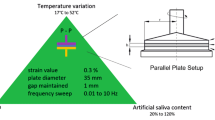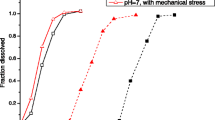Abstract
Purpose. This study examined the rheological and textural characteristics (hardness, compressibilty, adhesiveness and cohesiveness) of bioadhesive oral gels containing the antimicrobial agent chlorhexidine.
Methods. Textural analysis was performed using a Stable Micro Systems texture analyser (model TA-XT 2) in texture profile analysis (TPA) mode. In this, an analytical probe was twice compressed into each formulation to a defined depth (15 mm) and at defined rates (2, 4, 6, 8, 10 mm s−1), allowing a delay period (15 s) between the end of the first and beginning of the second compressions. Flow rheograms were performed using a Carri-Med CSL2-100 rheometer with parallel plate geometry under controlled shearing stresses at 20.0 ± 0.1°C.
Results. All formulations exhibited pseudoplastic flow with thixotropy. Increasing concentrations of each polymer significantly increased formulation hardness, compressibility, adhesiveness and zero-rate viscosity. Increased hardness and compressibility were due to the attendent increased viscosities of these formulations. Increased adhesiveness was related to the concentrations of the (bioadhesive) polymers employed in these formulations and, in addition, was dependent on the physical state of polycarbophil. Formulation viscosity contributed to product adhesiveness, reflecting the importance of product rheology on this parameter. Decreased formulation cohesiveness, observed as the concentrations of the PVP, PC and HEC (3−5%w/w) were increased, was due an increase in semi-solid character. Numerical values of hardness, compressibility and adhesiveness were affected by the choice of probe speed, a parameter related to rate of shear in flow rheometry. Statistical interactions were observed and were assigned to the effects of HEC on the physical state of PVP (dissolved or dispersed) and PC (swollen or unswollen).
Conclusions. This study has demonstrated both the applicability of textural analysis for the mechanical characterisation of bioadhesive semi-solid gel systems and, additionally, the direct influence of viscosity on the parameters defined by textural analysis, namely, hardness, compressibility and adhesiveness.
Similar content being viewed by others
REFERENCES
Addy, M. Adv. Drug Deliv. Rev. 13:123–134 (1994).
Roberts, W. R. and Addy, M., J. Clin. Periodontol. 8:295–310 (1981).
Moran, J., Addy, M., and Newcombe, R. J. Clin. Periodontol. 15:193–199 (1988).
Kornman, K. S. A review of current concepts. J. Periodontol. Res. 21:(Suppl. 16) 5–22 (1986).
Barkvoll, P., Rolla, G., and Svendsen, A. J. Clin. Periodontol. 16:593–598 (1989).
Jenkins, S., Addy, M., and Newcombe, R. J. Clin. Periontol. 18:140–144 (1991).
Gandhi, R. B. and Robinson, J. A. Adv. Drug Deliv. Rev. 13:(1994) 43–74.
Jones, D. S., Woolfson, A. D., Djokic, J., and Coulter, W.A. Pharm. Res. 13:1734–1738 (1996).
Breene, W. M. J. Text. Studies 6:53–82 (1975).
Sherman, P. J. Food Sci. 34:458–463 (1969).
McClelland, C., Irwin, C. R., Jones, D. S., Brown, A.F., and Woolfson, A. D. J. Dent. Res. (1997) in the press.
Jones, D. S., Woolfson, A. D., and Djokic, J. J. Appl. Poly. Sci. 61(12):2229–2234 (1996).
Barry, B. W., and Meyer, M. C. Int. J. Pharm. 2:1–25 (1979).
Cross, M. M. J. Colloid Sci. 20:417–437 (1965).
Ferrari, F., Bertoni, M., Caramella, C., and La Manna, A., Int. J. Pharm. 109:115–124 (1994).
McTaggart, L. E., and Halbert, G. W. Int. J. Pharm. 100:199–206 (1994).
Lucero, M. J., Vigo, J., and Leon, M. J. Int. J. Pharm. 111:261–269 (1994).
Lucero, M. J., Vigo, J., and Leon, M. J. Drug Devel. Indust. Pharm. 20(14):2315–2322 (1994).
Smart, J. D., Kellaway, I. W., and Worthington, H. E. C. J. Pharm. Pharmacol. 36:295–299 (1984).
Chu, J. S., Chandrasekharan, R., Amidon, G., Weiner, N. D., and Goldberg, A. H. Pharm. Res. 8:1408–1412 (1991).
Tamburic, S. and Craig, D. Q. M. J Cont. Rel. 37:59–68 (1995).
Szczesniak, A. S., Brandt, M. A., and Friedman, H. H. J. Food Sci. 28:397–403 (1963).
Schwartz, N. O. J. Text. Studies, 42:33–42 (1975).
Author information
Authors and Affiliations
Corresponding author
Rights and permissions
About this article
Cite this article
Jones, D.S., Woolfson, A.D. & Brown, A.F. Textural Analysis and Flow Rheometry of Novel, Bioadhesive Antimicrobial Oral Gels. Pharm Res 14, 450–457 (1997). https://doi.org/10.1023/A:1012091231023
Issue Date:
DOI: https://doi.org/10.1023/A:1012091231023




